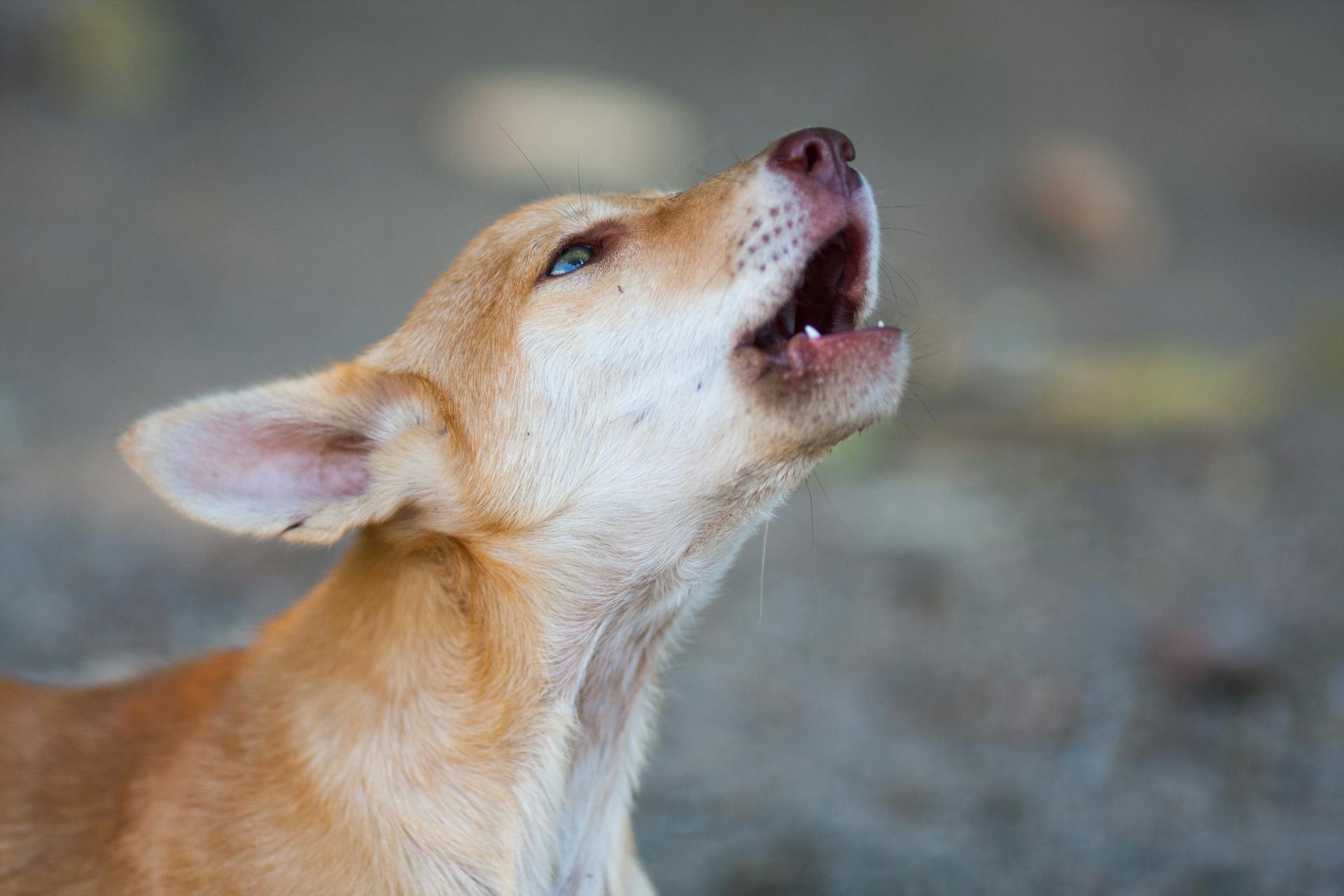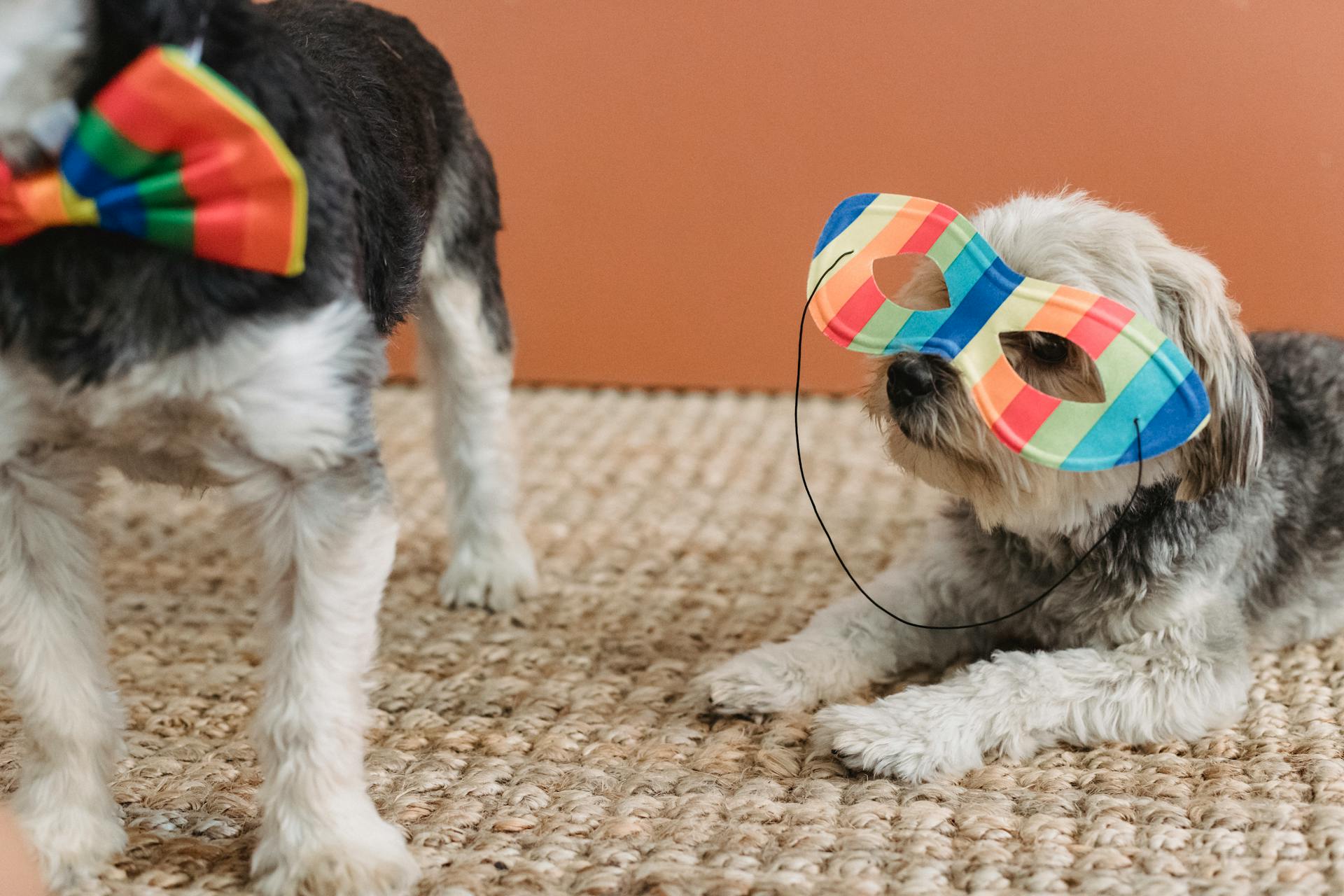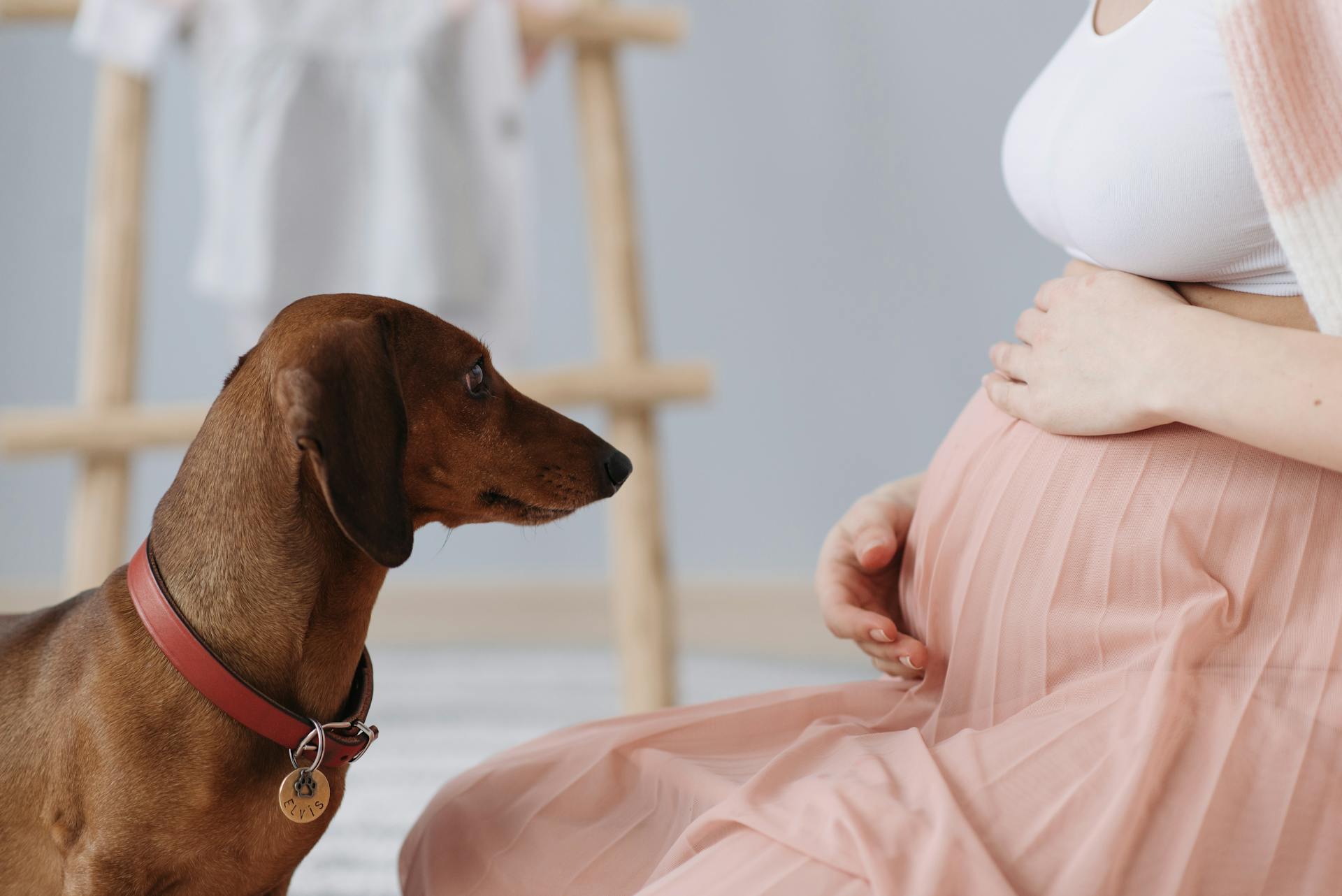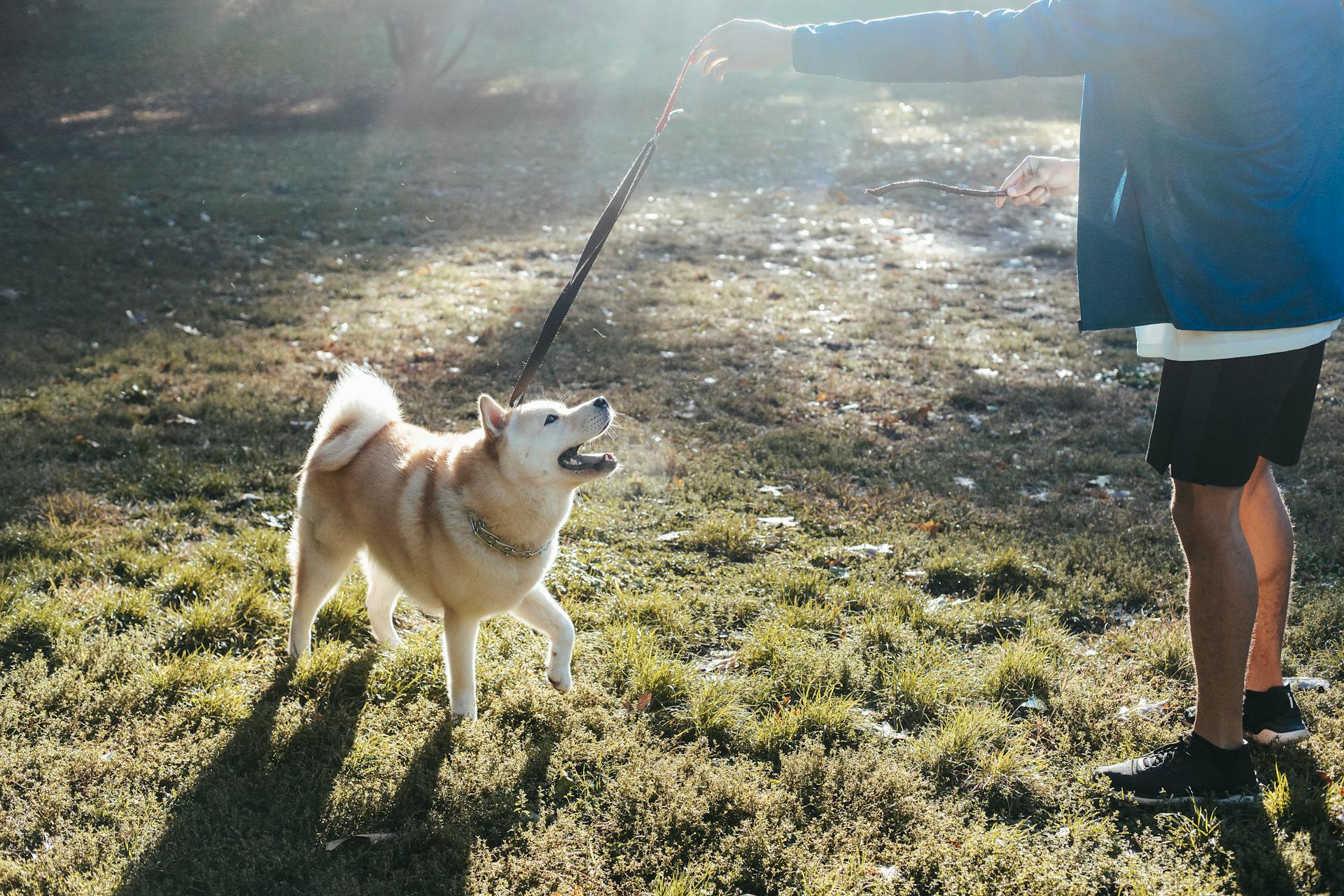
Dog button training is a simple yet effective way to enhance your relationship with your furry friend. It allows you to communicate with your dog in a fun and engaging way, and it's surprisingly easy to learn.
By using a button or a device with buttons, you can teach your dog to perform various tasks, such as pressing a button to get a treat or to initiate play. This type of training is especially beneficial for dogs with special needs or those who are easily distracted.
With practice and patience, you can teach your dog to use a button to communicate their needs, wants, and even emotions. For example, a dog may press a button to indicate they need to go outside, or to ask for a belly rub.
The key to successful dog button training is to start with simple tasks and gradually increase the complexity as your dog becomes more confident and proficient.
Getting Started
To get started with dog button training, have the buttons you want to teach your dog to use in mind and ready to go for each training session. It's best to choose a location for training that's relevant to the button, like the elevator for teaching your dog to push the button for a specific floor.
High-value treats are beneficial during the short training sessions, so have those on hand as well. Using treats that are different from your dog's everyday rewards will help keep them engaged.
Start by teaching your dog to associate the button with a specific action or object, like placing the "outside" button next to the door. This will help your dog make the connection between the sound and the action.
It's essential to keep the number of buttons to one or two at first, choosing words your dog already knows well, like "treat", "outside", and "walk." This will make the training process less overwhelming for your pup.
Readers also liked: It's Your Choice Dog Training
Training Methods
To start training your dog, you'll want to choose a method that works for you both. The Repetition Method is a great place to begin, where you show your dog the button they need to learn to push in various environments.
You can use a button on a phone, remote, crosswalk, medical device, or elevator as a starting point. I've seen dogs learn quickly with a button on a remote, as it's often within reach and easy to press.
For target training, you'll want to reward your dog for hitting the target with a treat. This can be as simple as placing their nose, paw, or claw on a nonsense sound button.
It's essential to avoid using actual word buttons, unless you can follow through with the button's meaning. For example, if your dog presses "outside", they should get to go outside.
Expand your knowledge: Target Training Dog
Target Training
Target training is a great way to teach your dog to pay attention to buttons, and it can be a fun and rewarding experience for both you and your dog.
To start target training, you'll want to reward your dog for hitting the target with a treat. This can be as simple as a nonsense sound button, small yogurt lid, or sticky note.
Reward your dog quickly when you see them looking at the target, and then gradually move on to rewarding them for moving closer to the target, and eventually for touching it.
Using a clicker and treats can be a great way to teach your dog to touch a button. Offer your dog a click and treat when they touch your clicker hand near the button with their nose.
As your dog becomes more confident, you can introduce different buttons and use the same rewarding process to teach them to touch and push each button.
Teaching your dog to push a button can be incredibly beneficial, and it's not just for service dogs or therapy dogs. Any dog can learn to push buttons, and it can be a great way to give them a job to do around the house.
To get started, simply introduce the button you'd like your dog to push and give it a name.
Curious to learn more? Check out: Clicker Dog Training
Tips and Strategies
Taking a positive approach is key to successful dog button training. Reward your dog for doing the right thing, and they'll be much more likely to do the same thing again.
Start with something basic, like "toy" or "outside", and make sure your dog masters this first button before moving on to another. Introducing an extra button at this early stage will be confusing for your dog.
Take things slow and stick with the same button until your pup starts to get the idea. This could take some time, and that's okay. In the beginning, it could take a while to get your pup to even acknowledge the buttons exist.
To really take your dog's button skills to the next level, make sure you use them on a day-to-day basis. If your pupper wants to go outside, wait for them to press the correct button before letting them out and giving them a reward.
Some common things to teach your dog include "toy", "food", "treat", "outside", "walk", "potty", "hello", "love you", "play", "ball", "bed", and names of people or other pets.
Recommended read: Dog Training and Daycare
Use Positive Reinforcement
Positive reinforcement is key to successful dog button training. Use lots of tasty treats to make the process fun and rewarding for your dog.
Get your dog's attention with treats and praise, even for a quick sniff at the buttons. This will create positive associations and keep the process upbeat and fun.
Treats and praise are important tools to have in the arsenal during button training. Use them to give your dog an instant reward for each successful step they take on their learning journey.
The secret to teaching your dog to "talk" with buttons is positive reinforcement. Reward your dog for doing the right thing, and they'll be much more likely to do the same thing again.
By using positive reinforcement, you can turn button training into a fun and rewarding experience for your dog.
On a similar theme: Dog Training Positive Reinforcement
Training Basics
To start training your dog to push a button, begin by rewarding them with a treat for hitting the target, such as a nonsense sound button, small yogurt lid, or sticky note.
You'll want to avoid using actual word buttons unless you can follow through with the button's meaning, as this can lead to confusion.
Teaching your dog to push a button takes a lot of time and patience, so be prepared to break it down into very short sessions to keep their attention.
Overview
Training your dog to use buttons takes patience and repetition. It's essential to keep training sessions short and focused to avoid losing your dog's attention.
You'll want to start with basic and advanced obedience training, such as heel, before teaching your dog to push buttons. This will help them understand the commands and build a strong foundation for more complex tasks.
To begin target training, reward your dog for touching a predetermined object, like a nonsense sound button or a sticky note. This will help them associate the object with a reward and build their confidence.
Here's a step-by-step guide to get you started:
- Choose a target object and reward your dog for touching it.
- Gradually move the object closer to the button and reward your dog for touching it.
- Introduce the button and reward your dog for touching it.
- Link the button to an event or item, such as a walk or a toy.
Remember to use shaping to break down complex behaviors into smaller steps, and to reward your dog frequently to keep them engaged and motivated.
What Are
Training is a process that involves teaching a dog new behaviors or habits. It's essential to establish a strong bond with your dog based on trust and respect.
Positive reinforcement is a key technique in dog training, where good behavior is rewarded with treats and praise. This approach helps your dog associate desired actions with positive outcomes.
Consistency is crucial in dog training, as dogs thrive on routine and predictability. A consistent training schedule can help prevent confusion and ensure your dog learns quickly.
Clear communication is vital in dog training, using verbal cues and hand signals to convey what you want your dog to do. This helps your dog understand what's expected of them.
Training sessions should be short and frequent, ideally lasting 10-15 minutes, to keep your dog engaged and focused. This also helps prevent overexertion and burnout.
Get to Know Your Learner
Get to know your learner's quirks, like expecting walks after dinner or waking you up at 5 AM for cuddles.
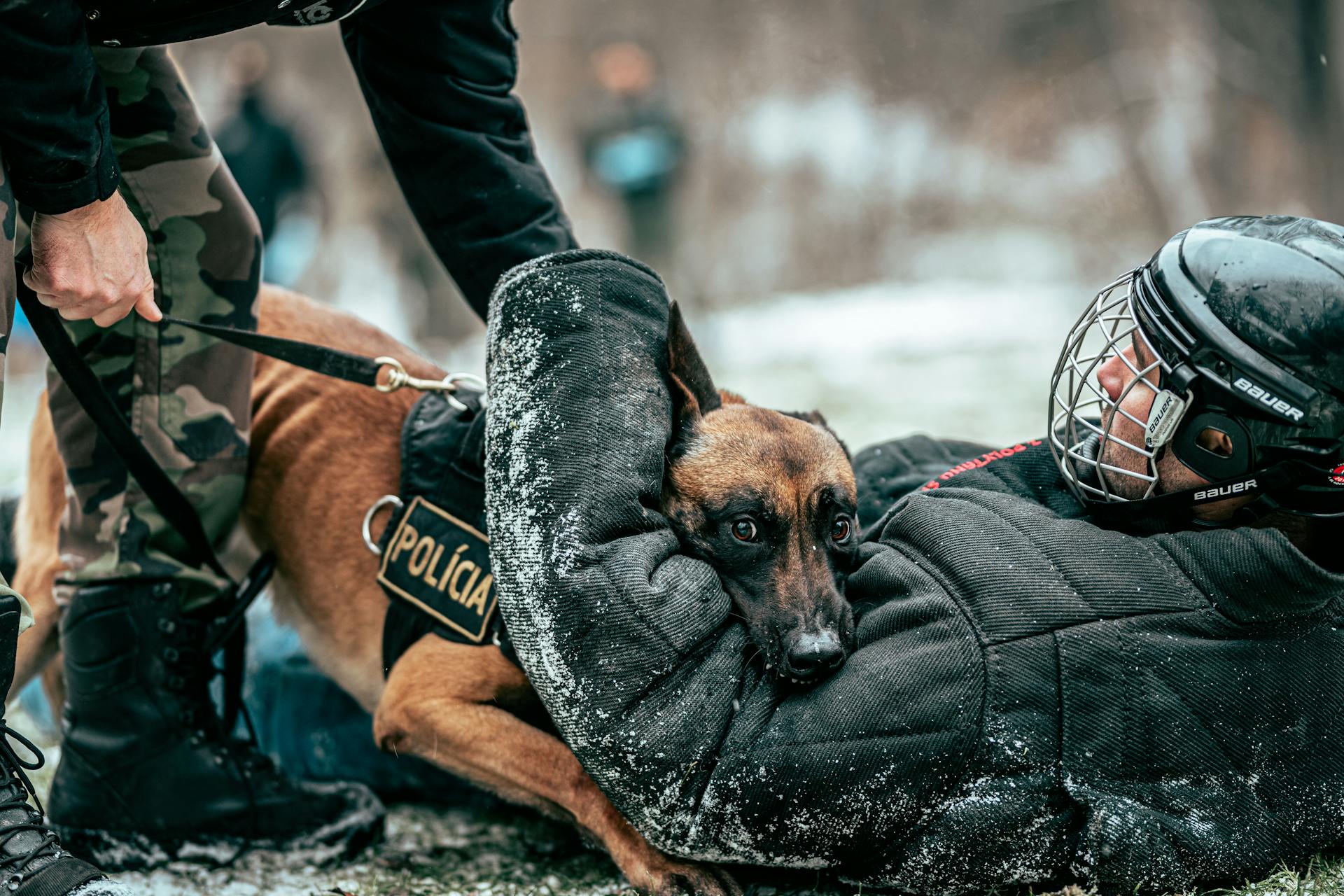
These quirks can give you clues about what words to start with when teaching buttons. For example, if saying "PARK" gets your learner overexcited, try spelling it out loud instead.
Recognize the words you speak the most, as these will likely be the first ones your learner picks up on for button teaching.
Knowing these words can help you tailor your approach to your learner's unique needs and preferences.
Here's an interesting read: List of Marker Words for Dog Training
Practice
Encourage your dog to nudge items and buttons. This will take some time, but once he gets the nudging idea down, he should be able to push buttons with his nose.
To start, practice with your dog nudging items, it's essential to be patient as this process can take time.
As your dog becomes more comfortable with nudging, he'll begin to associate the action with the desired outcome, such as treats and praise.
Practice regularly to reinforce what your dog has learned, and he'll eventually be able to push buttons with ease.
Setting Up and Preparing
To start dog button training, it's essential to have the right setup and preparation in place.
Choose the buttons you want your dog to learn to press and have them ready for each training session. For instance, if you're teaching your dog to close or open doors on an elevator, your training sessions will need to take place in that elevator.
High-value treats will be beneficial during the short training sessions. Entice your dog with treats that are different than the ones he gets for everyday good behavior and obedience.
Place each button close to the item or activity associated with the sound, such as the "outside" button next to the door. This will help your dog link the sound with the action.
Start with one or two buttons, choosing words your dog is already familiar with, like "potty", "play", or "walk." Record the words onto the buttons, using just one word per button.
Expand your knowledge: When to Start Dog Training Classes
General Information
Dog button training is a great way to communicate with your furry friend.
You can technically train any dog to use the buttons, but it depends on your dog's individual personality and the teaching process.
It's similar to teaching a dog how to grab their leash when they're ready for a walk or ring a bell when they need to go outside.
Broaden your view: Teaching Dog to Sit
Terminology
In our communication system, a learner is any non-human individual you're teaching to use button communication.
We use a specific terminology to define the concepts and words. The word/phrase is the sound produced by the button when it's pressed.
The meaning or concept is your actual definition of the word, and we use CAPITALIZED LETTERS to specify it. For example, "Baño" is the concept BATHROOM.
In our system, we use words and phrases to convey meaning, and each word has a specific definition. The definition is what you intend to convey with the word.
A different take: Dog Training Words
Can Any Use?
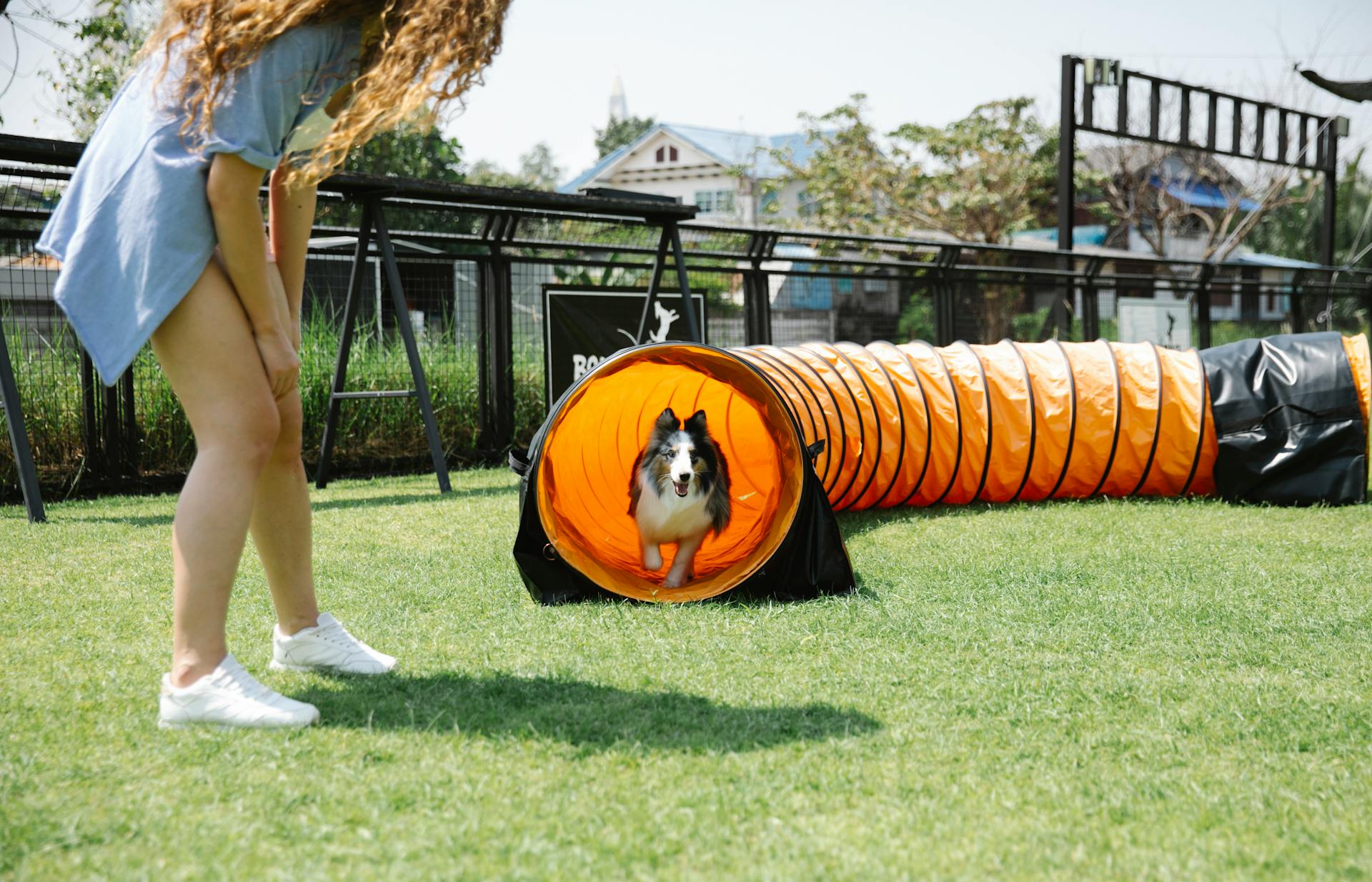
You can train any dog to use talk buttons, just like teaching them to grab their leash or ring a bell when they need to go outside.
The key to success lies in the dog's individual personality and the teaching method used. It's not about the type of dog, but rather their willingness to learn and adapt.
The number of buttons a dog learns and their consistency in performing depends on their individual abilities and the teaching. Some dogs may pick up multiple buttons quickly, while others may need more time and practice.
With patience and consistent training, even the most stubborn dog can learn to use talk buttons.
A different take: Teaching Dog Obedience
Sources
- https://wagwalking.com/training/push-a-button
- https://fluent.pet/pages/getting-started-with-talking-buttons
- https://be.chewy.com/dog-buttons/
- https://wagwalking.com/daily/how-do-i-teach-my-dog-to-speak-with-buttons-8-training-tips
- https://neaterpets.com/blogs/news/tiktok-dog-talk-buttons-train-dog-to-use
Featured Images: pexels.com
